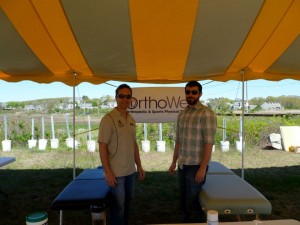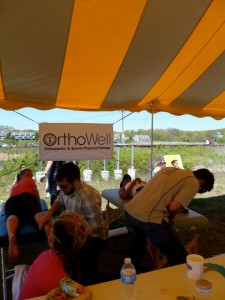Proper Breathing – The Cure for Pain & Stress?
What do you think of when you visualize someone who is really stressed out? It sure seems like some people are wound tightly these days. I have had my own issues with stress. I’m sure you have too. I find myself talking more and more with my patients about the effects of stress and how beneficial diaphragmatic breathing and proper nutrition can be. We will discuss nutrition in an upcoming post. You also need to be aware of other possible manifestations of stress like increased muscle tone, rapid heart rate, palpitations, increased blood pressure, GI distress, mood swings, loss of appetite, and sleep disturbances to name just a few. These symptoms make living a happy, relaxed and “normal” life much more difficult.
So what about the relationship between stress and breathing? Breathing occurs at a very primal level. If you don’t breathe, you don’t live! Your body will do whatever it takes to draw air into the lungs. Instead of using the diaphragm, it may recruit other accessory muscles in your neck or low back. This pattern reinforces poor posture and causes impaired flexibility which can promote shallow, ineffective breathing. It prevents the ability to exhale fully and to perform a proper, full diaphragmatic breath. Lets review what that means.
First of all, when performing a diaphragmatic breath, your belly should expand outward. This is due to the downward movement of your diaphragm as you inhale. Secondly, your lower ribcage should expand. Thirdly, your upper ribcage will expand during a maximal inhalation. Your ribcage should expand as a unit. It should NOT elevate. Movement of your ribcage upward, shoulder shrugging, or contraction of your neck muscles are all signs of faulty breathing patterns. Remember that slouched sitting and forward head posture encourages shallow breathing and prevents full, complete expansion of your ribcage. We discussed breathing pattern disorders in relation to CORE activation during my last post and video demonstration. Here it is in case you missed it:
So what does the research say about the link between pain and breathing disorders? A very interesting phenomenon is the prevalence of pain syndromes that are NOT caused by a specific organic illness. Katon & Walker (1998) noted that patients with the most common physical symptoms (i.e. abdominal pain, chest pain, headache, back pain), are responsible for half of all primary care visits in the USA, and yet only 10%–15% of these are found to be caused by organic illness! All these symptoms are well recognized as capable of being the result of breathing pattern disorders.
Perri and Holford (2004) evaluated 111 patients attending a chiropractic pain clinic and found 56.4% demonstrated faulty breathing on relaxed inhalation, increasing to 75% when taking a deep breath. 87% reported a history of various musculoskeletal pain problems. Based on this population, they observe that: “Chances are 3 in 4 that new patients seen today will have faulty breathing patterns.”
So what does the research say about the effects of breathing exercises on stress? Remember, stress reactions are controlled by our autonomic nervous system i.e. sympathetic and parasympathetic. Fight or flight? In Pal and colleagues, breathing exercises were shown to enhance the parasympathetic (inhibitory or calming) effects and decrease the sympathetic (excitatory) effects of muscles and nerves. They improve respiratory and cardiovascular function and improve both physical and mental health. Convinced yet?
So how do you begin breathing exercises?The first step is understanding that the relaxation response has to be relearned. You need to learn how to identify and turn off the stress response. As stated by Kabat-Zinn, “you need to learn how to replace negative thoughts and physical tension with regular practice of ‘calm stillness of mind and body’ “. Buddha is in the house! The next step is to schedule regular daily practice. You need to invest 10-15 minutes at least one time every day. According to Leon Chaitow, we need to “restore an energy-efficient, low chest, nose-breathing pattern with a relaxed pause at the end of exhalation”. He calls it “low slow nose breathing”. Initially, lay comfortably supported by pillows in a quiet room. Progress to sitting once a positive outcome is achieved in lying. You need to reinforce proper posture at home, work, and car and realize that breathing and relaxation techniques only help eliminate the symptoms, not the causes of stress. Be honest about making realistic lifestyle changes. The video below demonstrates a method that uses both breathing and physical relaxation techniques.
Remember that breathing drives everything that happens, both good and bad, throughout our entire bodies. So breathe right to live right!!




